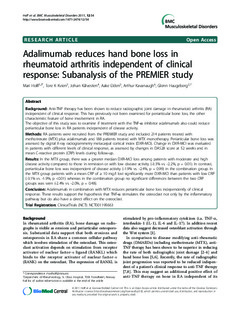| dc.contributor.author | Hoff, Mari | |
| dc.contributor.author | Kvien, Tore Kristian | |
| dc.contributor.author | Kälvesten, Johan | |
| dc.contributor.author | Elden, Aake | |
| dc.contributor.author | Kavanaugh, Arthur | |
| dc.contributor.author | Haugeberg, Glenn | |
| dc.date.accessioned | 2015-09-21T13:10:48Z | |
| dc.date.accessioned | 2016-04-15T13:48:59Z | |
| dc.date.available | 2015-09-21T13:10:48Z | |
| dc.date.available | 2016-04-15T13:48:59Z | |
| dc.date.issued | 2011 | |
| dc.identifier.citation | BMC Musculoskeletal Disorders 2011, 12 | nb_NO |
| dc.identifier.issn | 1471-2474 | |
| dc.identifier.uri | http://hdl.handle.net/11250/2385857 | |
| dc.description.abstract | Background: Anti-TNF therapy has been shown to reduce radiographic joint damage in rheumatoid arthritis (RA)
independent of clinical response. This has previously not been examined for periarticular bone loss, the other
characteristic feature of bone involvement in RA.
The objective of this study was to examine if treatment with the TNF-a inhibitor adalimumab also could reduce
periarticular bone loss in RA patients independent of disease activity.
Methods: RA patients were recruited from the PREMIER study and included 214 patients treated with
methotrexate (MTX) plus adalimumab and 188 patients treated with MTX monotherapy. Periarticular bone loss was
assessed by digital X-ray radiogrammetry metacarpal cortical index (DXR-MCI). Change in DXR-MCI was evaluated
in patients with different levels of clinical response, as assessed by changes in DAS28 score at 52 weeks and in
mean C-reactive protein (CRP) levels during follow-up.
Results: In the MTX group, there was a greater median DXR-MCI loss among patients with moderate and high
disease activity compared to those in remission or with low disease activity (-3.3% vs. -2.2%, p = 0.01). In contrast,
periarticular bone loss was independent of disease activity (-1.9% vs. -2.4%, p = 0.99) in the combination group. In
the MTX group patients with a mean CRP of ≥ 10 mg/l lost significantly more DXR-MCI than patients with low CRP
(-3.1% vs. -1.9%, p <0.01) whereas in the combination group no significant differences between the two CRP
groups was seen (-2.4% vs. -2.0%, p = 0.48).
Conclusion: Adalimumab in combination with MTX reduces periarticular bone loss independently of clinical
response. These results support the hypothesis that TNF-a stimulates the osteoclast not only by the inflammatory
pathway but do also have a direct effect on the osteoclast. | nb_NO |
| dc.language.iso | eng | nb_NO |
| dc.publisher | BioMed Central | nb_NO |
| dc.rights | Navngivelse 3.0 Norge | * |
| dc.rights.uri | http://creativecommons.org/licenses/by/3.0/no/ | * |
| dc.title | Adalimumab reduces hand bone loss in rheumatoid arthritis independent of clinical response: Subanalysis of the PREMIER study | nb_NO |
| dc.type | Journal article | nb_NO |
| dc.type | Peer reviewed | nb_NO |
| dc.date.updated | 2015-09-21T13:10:48Z | |
| dc.source.volume | 12 | nb_NO |
| dc.source.journal | BMC Musculoskeletal Disorders | nb_NO |
| dc.identifier.doi | 10.1186/1471-2474-12-54 | |
| dc.identifier.cristin | 827571 | |
| dc.description.localcode | © Hoff et al; licensee BioMed Central Ltd. 2011. This is an Open Access article distributed under the terms of the Creative Commons Attribution License (http://creativecommons.org/licenses/by/2.0), which permits unrestricted use, distribution, and reproduction in any medium, provided the original work is properly cited. | nb_NO |

